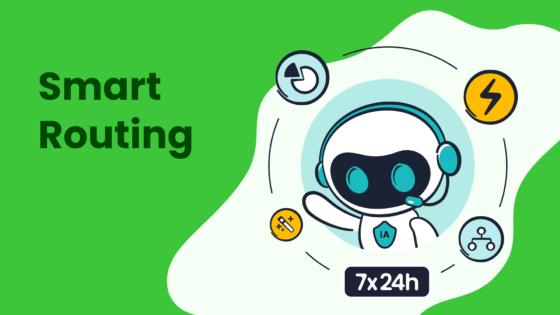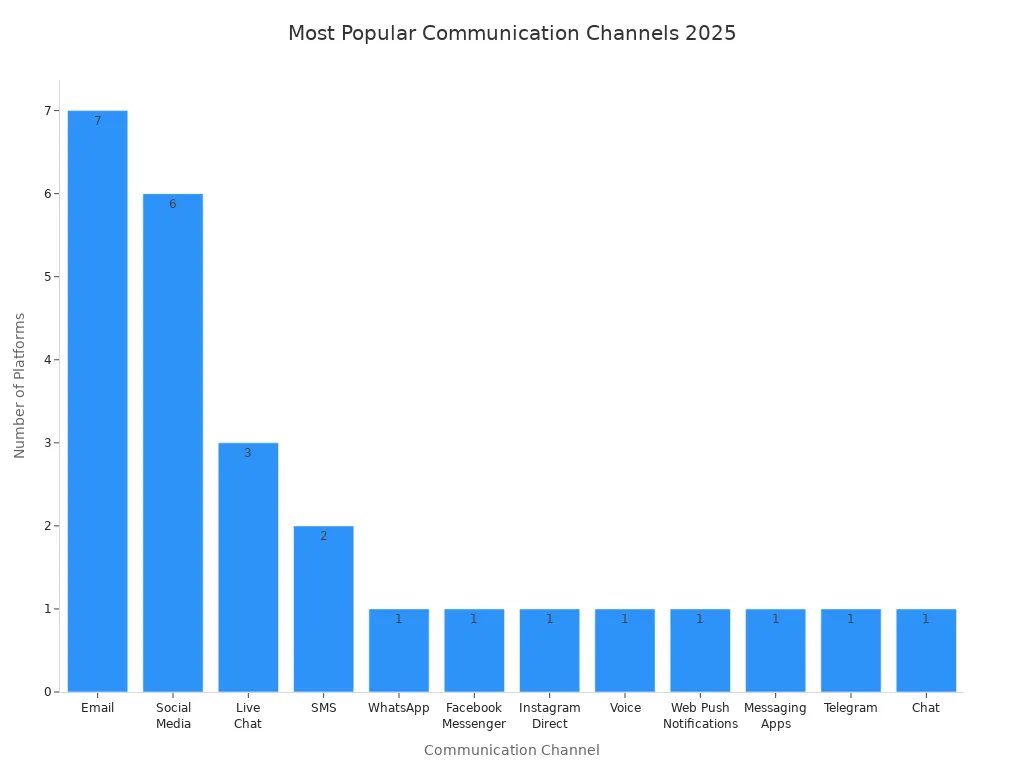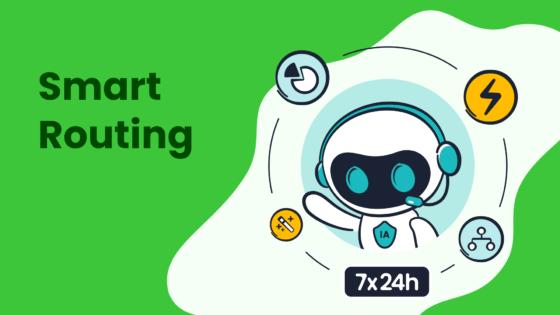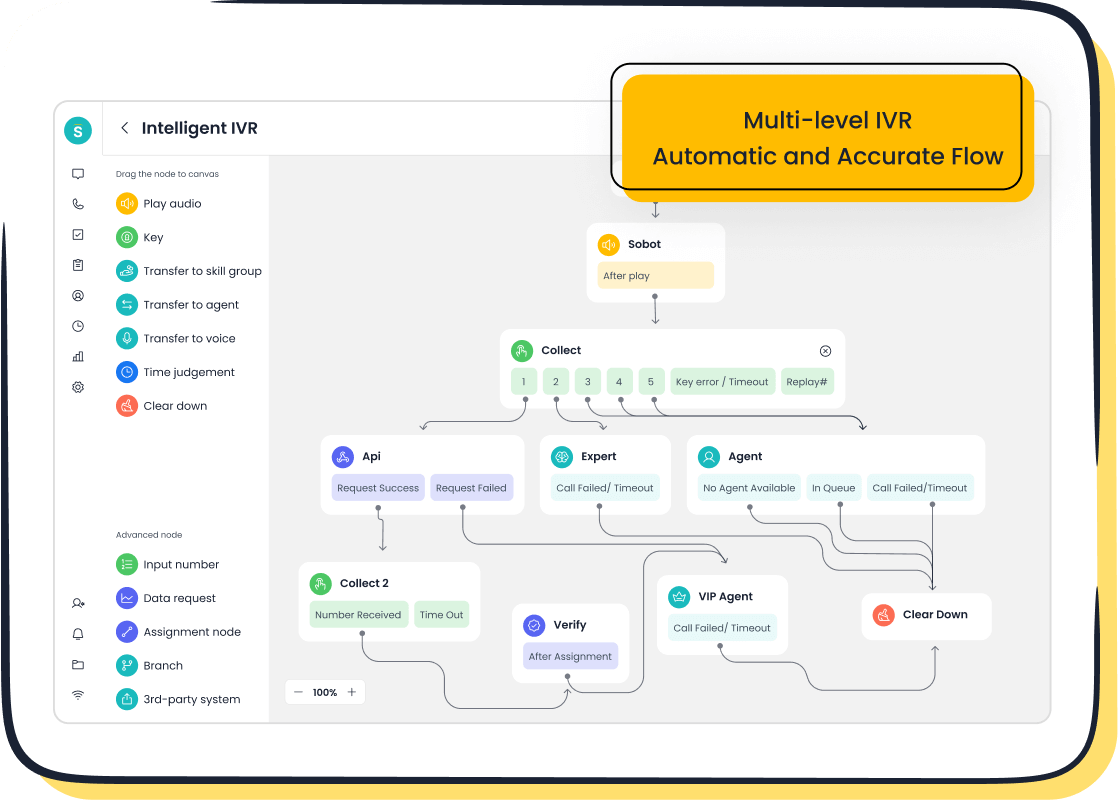Best Omnichannel Service Platforms for Modern Businesses

Businesses in 2025 rely on leading omnichannel service platforms such as Sobot, Salesforce Service Cloud, Zendesk, Intercom, LiveAgent, Talkdesk, Nextiva, Kustomer, Sprinklr, HubSpot Service Hub, Freshdesk, and Zoho. These solutions enable seamless engagement and unified service across channels, which has become essential as over 90% of companies use or plan to use omnichannel strategies. Platforms like Sobot AI and the Sobot call center boost efficiency, retention, and customer satisfaction by providing integrated omnichannel service and tailored engagement.
Omnichannel Service Platform Overview

What Is an Omnichannel Service Platform
An omnichannel service platform connects all customer touchpoints into a single, unified system. Leading industry analysts describe omnichannel as a seamless and consistent approach to selling, marketing, and customer service across every channel. This approach integrates multiple technologies and touchpoints, ensuring customers receive consistent customer experiences whether they interact through chat, email, phone, or social media. Unlike multichannel systems, which often operate in silos, omnichannel platforms focus on integration and cohesion. Businesses use these platforms to manage inventory, orders, payments, and marketing automation, creating a true omnichannel commerce platform.
- Omnichannel service platforms:
- Deliver a unified, cohesive customer experience.
- Integrate data and messaging across all departments.
- Support a mapped and strategically aligned buyer journey.
- Enable businesses to provide personalized shopping experiences at scale.
The table below highlights the main differences between multichannel and omnichannel approaches:
| Aspect | Multichannel Marketing | Omnichannel Marketing |
|---|---|---|
| Integration | Channels operate independently, often isolated | Channels and touchpoints are fully integrated and coordinated |
| Customer Experience | Fragmented, impersonal, disconnected | Seamless, consistent, personalized, and contextual |
| Messaging & Data | Disjointed messaging, no unified data | Unified messaging and data across departments and channels |
| Buyer Journey | Random, unaligned touchpoints | Mapped and strategically aligned journey |
| Strategic Focus | Presence on multiple channels | Relevance, empathy, and strategic alignment |
Why Omnichannel Matters
Omnichannel service platforms have become essential for modern businesses. Research shows that companies using an omnichannel strategy see a 13% increase in average order value and a 90% boost in customer retention compared to single-channel approaches. These results come from integrating promotion, product, price, transaction information, and customer service into one seamless experience. Customers benefit from consistent customer experiences, which build trust and loyalty.
Sobot, for example, offers an omnichannel commerce platform that unifies voice, chat, email, and social media in a single workspace. This integration allows agents to deliver fast, personalized support and helps businesses manage customer data efficiently. Companies like Opay have improved satisfaction rates and reduced costs by adopting Sobot’s omnichannel service platform.
Note: Omnichannel platforms help businesses meet rising customer expectations and adapt to rapid changes in digital commerce.
Key Features of Omnichannel Platforms
Unified Customer View
A unified customer view stands at the core of any effective omnichannel communication platform. This feature gathers customer data from multiple sales channels and presents it in a single, accessible profile. Companies like Room & Board and Royal Caribbean Cruise Lines have improved service delivery by using integrated systems that provide complete visibility into customer interactions. With this approach, agents can see every conversation, purchase, and support request, whether the customer reached out by email, chat, or phone. Sobot’s omnichannel solution offers a unified workspace, allowing agents to deliver consistent and personalized service across all touchpoints. This unified view helps businesses reduce downtime, optimize resources, and maintain high service quality.
A unified customer view enables teams to deliver seamless experiences both online and offline, supporting continuous improvement and customer satisfaction.
Channel Integration
Channel integration allows businesses to connect with customers through their preferred methods. Leading omnichannel platforms support a wide range of communication channels, including email, SMS, live chat, social media messaging apps, and voice. The table below shows the most popular channels integrated by top platforms in 2025:
| Platform | Integrated Communication Channels |
|---|---|
| Shopify Plus | Email, SMS, Live Chat, Social Media Messaging, Voice |
| Omnisend | Email, Social Media |
| HubSpot | Email, Social Media |
| Zendesk | Live Chat, Email, Social Media, Messaging Apps |
| Intercom | Email, Chat, Social Media with AI-driven automation |
| Callbell | WhatsApp, Facebook Messenger, Instagram Direct, Telegram |
| Klaviyo | Email, SMS, Web Push Notifications |

Sobot’s integration capabilities enable businesses to unify all these channels, ensuring no customer message goes unnoticed. This level of integration supports true omnichannel communication and helps brands manage interactions efficiently.
Automation and AI
Automation and AI have transformed the way businesses manage customer interactions. Top omnichannel communication platforms now use AI-driven personalization to automate routine tasks, predict customer needs, and deliver tailored responses. Platforms like Sobot leverage AI-powered chatbots and voicebots to provide 24/7 support, automate ticket routing, and analyze customer sentiment. Predictive analytics and real-time data processing allow companies to identify high-potential leads and respond quickly. As AI adoption grows, businesses see improved efficiency, higher satisfaction, and increased revenue.
- AI-driven personalization adapts to customer behavior across multiple sales channels.
- Real-time intelligence and unified data architectures enhance operational efficiency.
Analytics and Reporting
Analytics and reporting tools give businesses the insights needed to optimize their omnichannel strategy. These features track performance across all channels, measure customer satisfaction, and identify trends. Sobot’s analytics dashboard provides real-time monitoring and detailed reports, helping managers make data-driven decisions. With advanced reporting, companies can spot issues early, adjust strategies, and improve both agent productivity and customer experience.
Note: According to recent market surveys, essential features like unified customer data, real-time inventory routing, and lifecycle automation are critical for delivering a consistent and efficient omnichannel experience.
Top Omnichannel Platforms in 2025
Sobot Omnichannel Solution
Sobot stands out as a comprehensive omnichannel communication platform designed for modern businesses seeking seamless customer engagement. The platform integrates all customer channels—voice, chat, email, social media, WhatsApp, and SMS—into a single, unified workspace. This approach eliminates the need for multiple systems and reduces operational complexity.
Key strengths of Sobot include:
- All-in-one customer contact platform covering every channel and communication method.
- Five-AI system launched in 2024, featuring omnichannel AI, scenario-based AI for industries like e-commerce and retail, and multi-faceted AI components such as AI Agent, Copilot, and Insight.
- Generative AI powered by advanced large language models, including OpenAI, Amazon Bedrock, Anthropic Claude, and DeepSeek.
- Secure AI architecture ensuring data privacy and compliance.
- Over 300 statistical reports with thousands of indicators, supporting full customer engagement from first contact to ongoing management.
- Competitive pricing, often half or less than other omnichannel platforms, with no hidden charges.
- Seamless integration with popular platforms like Amazon, Walmart, Shopify, Salesforce, and flexible APIs for custom solutions.
- Trusted by over 100,000 companies across industries such as retail, finance, gaming, and manufacturing.

Sobot’s Voice/Call Center serves as a key differentiator for businesses needing advanced telephony and omnichannel integration. The Voice/Call Center offers intelligent IVR, unified agent workspace, real-time monitoring, bulk outbound tasks, global number availability, and AI-powered voicebots. The platform maintains a 99.99% uptime and supports global operations with 110 points of presence in 93 cities across 50 countries.
Sobot’s omnichannel solution fits organizations that require a scalable, secure, and AI-driven customer engagement platform. Companies like Opay have achieved a 90% customer satisfaction rate and reduced operational costs by over 20% after adopting Sobot’s solutions. The platform’s experience-led design and efficiency-driven features make it suitable for businesses of all sizes, from startups to global enterprises.
Sobot’s unified workspace and advanced analytics help teams deliver consistent, personalized service across every channel, driving higher customer satisfaction and operational efficiency.
Learn more about Sobot Omnichannel Solution
Salesforce Service Cloud
Salesforce Service Cloud ranks among the most recognized omnichannel support solutions for enterprises. The platform connects customer interactions across email, phone, chat, messaging apps, and social media. Its unified customer view allows agents to access complete interaction histories, enabling fast and personalized responses.
Salesforce Service Cloud’s strengths include robust case management, AI-powered automation with Einstein AI, and deep integration with the broader Salesforce ecosystem. The platform supports workflow automation, knowledge management, and predictive analytics. Businesses can customize the platform to fit industry-specific needs, making it ideal for large organizations with complex service requirements.
Best-fit scenarios include enterprises that already use Salesforce for CRM and want to extend their capabilities to omnichannel support. The platform’s scalability and integration options make it suitable for global brands seeking a unified customer engagement platform.
Zendesk
Zendesk provides a scalable omnichannel support platform tailored for mid-sized to enterprise-level companies. The platform excels in customer support, offering a powerful ticketing system, advanced reporting, and a wide range of integrations. Zendesk supports multiple communication channels, including email, chat, voice, social messaging, help center, and community forums.
The platform’s AI-driven features, such as AI agents and skills-based routing, enhance automation and efficiency. Zendesk’s best-fit scenarios involve organizations with complex support needs and large teams that require a comprehensive, support-centric omnichannel solution. Many advanced features are available as paid add-ons, which can increase costs for larger teams.
Intercom
Intercom focuses on conversational customer engagement, blending live chat, bots, and messaging into a unified omnichannel communication platform. The platform supports email, chat, and social media, with AI-driven automation for routing and responding to inquiries.
Intercom’s strengths include its user-friendly interface, proactive messaging, and robust automation tools. The platform is well-suited for SaaS companies, startups, and businesses that prioritize real-time customer engagement and personalized support. Intercom’s solutions help teams deliver fast, contextual responses, improving customer satisfaction and retention.
LiveAgent
LiveAgent offers an affordable omnichannel contact center solution for small to mid-sized businesses. The platform integrates email, live chat, phone, social media, and customer portal into a single dashboard. LiveAgent’s ticketing system ensures that no customer inquiry goes unanswered.
Key features include real-time chat, call center capabilities, automation rules, and a knowledge base. LiveAgent’s simple setup and transparent pricing make it accessible for businesses with limited IT resources. The platform fits companies seeking a cost-effective, easy-to-use omnichannel support solution.
Talkdesk
Talkdesk delivers a robust omnichannel contact center platform that combines voice and digital channels for seamless customer experiences. The platform’s Talkdesk Studio™ enables non-technical users to design customer journeys with intelligent orchestration and routing. Talkdesk Copilot™ provides AI-based agent assistance, offering real-time recommendations and automated support during live interactions.
Talkdesk supports proactive outbound engagement with advanced dialing modes and automated campaigns, including two-way SMS and email. The platform ensures seamless transitions across channels, maintaining full context for agents. Integration with CRM and workforce management tools enhances productivity and personalized service.
Talkdesk’s solutions have improved call quality, reduced call abandonment, and increased first contact resolution for clients in industries such as legal services and logistics. The platform is ideal for organizations that require advanced telephony, omnichannel integration, and AI-driven agent support.
Nextiva
Nextiva’s omnichannel platform unifies voice, video, chat, email, and SMS interactions, enabling personalized and proactive customer experiences. The platform supports sales and support teams by maintaining full customer context and leveraging AI for personalization.
| Industry | Use Case Description | Key Platform Features |
|---|---|---|
| Retail | Personalized shopping journey connecting social media, mobile, and in-store experiences with wishlist and purchase data. | AI-powered personalization, unified CRM, omnichannel messaging, seamless channel transitions. |
| Banking & Finance | Smooth loan application support across online chat and branch visits with shared application and chat history. | Unified customer view, real-time context sharing, proactive customer service. |
| Healthcare | Appointment reminders via SMS, rescheduling through mobile app, secure messaging with full interaction history stored. | Secure messaging, unified customer records, multi-channel support, consistent messaging. |
| Hospitality | Personalized recommendations via email, mobile app room service requests, preference tracking for future visits. | Customer preference tracking, feedback loop automation, multi-channel engagement. |
| FinTech | Multi-channel customer servicing for responsible lending, enabling outreach on preferred channels with full context. | Omnichannel contact center, AI capabilities, unified CRM, scalable personalized support. |
Nextiva’s platform fits organizations in retail, finance, healthcare, hospitality, and fintech that need to unify customer interactions and deliver consistent, personalized service across channels.
Kustomer
Kustomer provides an omnichannel customer engagement platform focused on delivering a unified customer view. The platform integrates chat, email, voice, SMS, and social messaging, allowing agents to manage all interactions from a single timeline.
Kustomer’s strengths include workflow automation, AI-powered insights, and deep CRM integration. The platform supports personalized service by consolidating customer data and interaction history. Kustomer fits businesses that prioritize customer-centric support and require a flexible, scalable solution for omnichannel communication.
Sprinklr
Sprinklr distinguishes itself as an omnichannel commerce platform with a strong emphasis on social media and digital engagement. The platform unifies social media, messaging, and digital channels, ensuring consistent brand experiences wherever customers interact.
Sprinklr integrates social listening, customer feedback management, media monitoring, and AI-powered insights. Brands can engage strategically and data-driven, using real-time consumer and brand intelligence to personalize communication. SAP, for example, standardized social listening and centralized reporting with Sprinklr, improving interaction rates and brand presence.
The unified agent desktop consolidates communication histories, allowing agents to manage multiple interactions seamlessly. Sprinklr’s solutions support community engagement and interactive content strategies, fostering customer loyalty and advocacy.
HubSpot Service Hub
HubSpot Service Hub offers an integrated omnichannel support platform within the broader HubSpot ecosystem. The platform connects email, chat, phone, and social media, providing a unified customer view and automated ticketing.
HubSpot Service Hub’s strengths include easy-to-use automation tools, knowledge base management, and customer feedback collection. The platform fits small to mid-sized businesses that already use HubSpot for marketing or sales and want to extend their capabilities to omnichannel support. HubSpot’s solutions help teams streamline workflows and improve customer satisfaction.
Freshdesk
Freshdesk delivers a flexible omnichannel support platform for businesses of all sizes. The platform integrates email, chat, phone, social media, and messaging apps, allowing agents to manage all interactions from a single dashboard.
Freshdesk’s features include AI-powered ticketing, automation, and self-service portals. The platform supports workflow customization and advanced analytics. Freshdesk fits organizations seeking a scalable, easy-to-implement omnichannel communication platform with strong automation and reporting capabilities.
Zoho
Zoho’s omnichannel platform unifies customer interaction channels such as phone, email, live chat, surveys, social media, WhatsApp, SMS, webforms, self-service portals, and web conferencing. The platform provides real-time unified customer signals and notifications through SalesSignals, enabling instant engagement.
Key capabilities include:
- Seamless team collaboration tools for unified campaigns and customer interactions.
- Contextual customer data integration across all channels for continuity and personalized service.
- Advanced website engagement features, such as geo-location, visitor scoring, audio calls, and screen sharing.
- Deep integration with telephony providers for call management, logging, reminders, and analytics.
- Social media monitoring and engagement tools for real-time responses and lead generation.
- Personalized email campaigns with templates, workflows, and dynamic content.
- Survey tools to gather feedback and convert responses into leads or tickets.
- Integration with over 500 third-party applications for extensive customization.
Zoho CRM allows businesses to manage multiple communication channels from one platform, maintaining context across all interactions. The platform fits organizations that need a unified, customizable omnichannel contact center and customer engagement platform.
Zoho’s solutions empower teams to deliver seamless, personalized service and drive customer loyalty through unified communication and collaboration.
Omnichannel Service Platform Comparison

Features and Channels
Omnichannel platforms in 2025 offer a wide range of features that help businesses manage multiple sales channels and deliver seamless customer experiences. Most leading platforms support integrations with Google Shopping, Facebook Shops, Amazon, eBay, Walmart, and Target+. They also connect with ecommerce platforms like Shopify, BigCommerce, Magento, WooCommerce, Oracle, Netsuite, and Salesforce Commerce Cloud. These integrations allow companies to unify online and offline sales, manage real-time inventory updates, and provide consistent service across every touchpoint.
| Platform | Focus Area | Key Features & Channels Supported | Ease of Use & Customization |
|---|---|---|---|
| Sobot | Unified customer contact | Voice, chat, email, WhatsApp, SMS, social, AI automation | User-friendly, scalable, flexible |
| Kustomer | Customer service | Email, chat, SMS, voice, social, workflow automation | Highly customizable |
| EngageLab | AI-powered engagement | Email, chat, SMS, voice, social, workflow engine | Moderate learning curve |
| Intercom | Conversational marketing | Chatbots, in-app messaging, email, help center | User-friendly, advanced features |
Note: Sobot stands out for its unified workspace and advanced AI, making it easy for teams to manage multiple sales channels from one platform.
Pricing and Scalability
Pricing models vary widely among omnichannel platforms. Sobot offers competitive pricing with flexible plans that scale as businesses grow. Many platforms, such as HubSpot Service Hub, provide tiered pricing starting from free or low-cost plans and increase with added features and users. For example, HubSpot starts with a free plan and goes up to $130 per month per seat. Zendesk and Kustomer have pricing that ranges from $19 to $115 per agent per month, depending on the level of service and automation required. As teams expand, costs can rise, so businesses should consider both current needs and future growth.
| Platform | Starting Price | Notable Pricing Model Features |
|---|---|---|
| Sobot | Custom, scalable | Flexible plans, global support |
| HubSpot | Free to $130/seat/mo | Tiered, scales with features/users |
| Kustomer | $89/agent/mo | Enterprise focus, workflow automation |
Use Cases
Businesses across industries use omnichannel solutions to improve customer engagement and streamline operations. Sobot’s platform has helped companies like OPPO achieve an 83% chatbot resolution rate and a 57% increase in repurchase rate by managing multiple sales channels efficiently. Opay, a financial service provider, used Sobot to unify social media, email, and voice support, raising customer satisfaction from 60% to 90% and reducing costs by 20%. These examples show how omnichannel solutions drive better service, boost loyalty, and support business growth.
Companies that adopt omnichannel solutions can expect higher customer satisfaction and improved operational efficiency.
Choosing the Right Omnichannel Platform
Business Size and Industry
Selecting an omnichannel platform starts with understanding business size and industry needs. Enterprises often require advanced features, such as AI-driven personalization and global support. Mid-market companies may prioritize ease of use and cost efficiency. Retail chains, B2B wholesalers, and fast-growing direct-to-consumer brands each have unique requirements. The table below outlines recommended platforms and key criteria for different business types:
| Business Size / Industry | Recommended Platform | Key Criteria / Advantages |
|---|---|---|
| Enterprise | Salesforce Commerce Cloud | AI-driven personalization, multi-language/currency, pricing for large-scale GMV |
| Enterprise | Adobe Commerce | High customization, strong B2B features, cloud deployment |
| Mid-Market | Shopify Plus | Ease of use, large app marketplace, good for retail chains |
| Mid-Market | BigCommerce | Flexible APIs, cost-efficient, high ROI, good for fast-growing D2C |
| Retail Chains | Shopify Plus | Combines in-store and online operations |
| B2B Wholesale | Adobe Commerce | Workflow automation, deep customization |
| Global Brands | Salesforce Commerce Cloud | Optimizes cross-border commerce |
| Fast-Growing D2C | BigCommerce | Scales quickly to meet demand |
Sobot’s omnichannel solution adapts to businesses of all sizes, supporting industries from retail to finance. Its flexible deployment and scalable features make it a strong choice for both growing companies and established enterprises.
Tech Stack Integration
A successful omnichannel strategy depends on seamless integration capabilities. Businesses should ensure their chosen platform connects easily with existing CRM, ERP, and marketing tools. Sobot offers robust integration with popular systems like Salesforce and Shopify, allowing teams to unify customer data and streamline workflows. This approach reduces manual work and improves service consistency.
Tip: Always check for API availability and pre-built connectors to minimize setup time and technical challenges.
Budget and ROI
Budget plays a key role in platform selection. Companies should look beyond upfront costs and consider long-term value. Adopting an omnichannel service platform often leads to impressive returns:
- Omnichannel shoppers generate a 30% higher lifetime ROI than single-channel shoppers.
- Companies with omnichannel engagement see sales revenue growth 179% higher than those without.
- Average sales revenue increases by 9% with omnichannel customer engagement.
- Omnichannel retailers retain 90% more customers than single-channel stores.
These figures show that investing in the right platform can drive revenue and customer loyalty. Source.
Implementation Support
Implementation support ensures a smooth transition to a new platform. Businesses should evaluate the quality of onboarding, training, and ongoing assistance. Sobot provides dedicated support, training resources, and regular updates, helping teams maximize platform benefits from day one. Reliable support reduces downtime and accelerates return on investment.
Note: Strong vendor support can make a significant difference in adoption speed and long-term success.
Benefits of Omnichannel Service
Customer Experience
Omnichannel service platforms transform customer experiences by providing seamless handoffs and transparency across every channel. Customers can start a conversation on social media and finish it by phone or email without repeating themselves. This approach removes friction and builds trust. Sobot, for example, unifies all touchpoints in a single workspace, allowing agents to deliver consistent customer experiences. Companies using omnichannel service see higher Net Promoter Scores (NPS) and increased customer satisfaction. Customers feel valued and understood, which leads to stronger relationships and more referrals.
Efficiency and Productivity
Businesses that adopt omnichannel service platforms notice a sharp rise in efficiency and productivity. Agents handle more inquiries and resolve issues faster. Sobot’s AI-powered tools automate routine tasks, freeing agents to focus on complex problems. This leads to shorter response times and improved agent experience scores. Operational efficiency also improves as call volumes drop and operating costs decrease. Teams can manage all customer engagement from one platform, reducing time spent switching between systems.
Tip: Automation and unified workspaces help agents work smarter, not harder.
Data Insights
Omnichannel service platforms collect valuable data from every customer interaction. This data includes customer behavior, sentiment, and preferences. With advanced analytics, businesses can spot trends, measure performance, and personalize marketing efforts. Sobot’s analytics dashboard provides real-time insights, helping managers make informed decisions. Data-driven strategies lead to continuous improvement and more personalized customer experiences.
| Benefit Category | Measurable Benefits and Metrics |
|---|---|
| Agent Productivity | Increased inquiry capacity, improved agent experience scores |
| Service Speed | Shorter response times, faster issue resolution |
| Customer Satisfaction & Loyalty | Higher NPS, reduced churn, increased retention and referrals |
| Operational Efficiency | Reduced call volumes, lower operating costs |
| Customer Experience | Seamless handoffs, transparency, personalized support, frictionless journeys |
| Data-Driven Insights | Collection of behavior and sentiment data for continuous improvement |
| Customer Trust & Engagement | Stronger relationships, increased engagement and brand advocacy |
| Technology Enablement | 24/7 support with AI, freeing agents for complex issues |
Growth Potential
Omnichannel service platforms drive business growth by improving customer engagement and loyalty. Companies that deliver consistent customer experiences retain more customers and see higher sales. Sobot’s customer engagement platform helps brands scale globally, supporting millions of interactions daily. As businesses grow, the platform adapts to new channels and markets. This flexibility ensures that customer experiences remain consistent, even as the company expands.
Consistent customer experiences and strong engagement fuel long-term business success.
Omnichannel Marketing Platforms Trends
AI and Automation
Omnichannel marketing platforms in 2025 rely on advanced AI and automation to deliver seamless customer engagement. These platforms use AI-driven personalization to create unified customer profiles and automate routine tasks. Businesses benefit from features like customer journey orchestration, real-time audience segmentation, and predictive analytics. AI-powered content optimization helps brands deliver the right message at the right time. Companies such as Netflix and Coca-Cola have seen higher engagement and revenue by using AI-driven segmentation and personalized marketing. The AI marketing industry is expected to reach $107.5 billion by 2028, growing at a rate of 36.6% per year (source). Sobot integrates AI-powered chatbots and automation into its omnichannel marketing platforms, helping businesses improve efficiency and customer satisfaction.
- AI automates repetitive work, freeing teams for strategic tasks.
- Unified customer profiles increase satisfaction and loyalty by up to 30%.
- Predictive lead scoring and automated segmentation drive better results.
Adopting AI in omnichannel marketing platforms is now essential for staying competitive.
Voice and Mobile Integration
Voice and mobile integration have become critical features in omnichannel marketing platforms. Customers expect to interact with brands through voice calls, mobile apps, and messaging services. Platforms like Sobot offer global voice solutions, smart call routing, and mobile compatibility. These features allow businesses to manage customer engagement across all devices and channels. Voicebots and mobile chatbots provide instant support, making personalized journeys possible. Companies that use voice and mobile integration see higher engagement rates and improved customer experiences.
- Voice and mobile channels support real-time communication.
- Mobile-first design ensures accessibility for all users.
- Voicebots handle high call volumes and automate responses.
Personalization
Personalization stands at the heart of successful omnichannel marketing strategy. Omnichannel marketing platforms use data from every touchpoint to create personalized shopping experiences. AI-driven personalization enables brands to deliver targeted offers, recommendations, and content. Sobot’s omnichannel engagement tools help businesses design personalized journeys that boost customer engagement and loyalty. Real-time analytics and unified data allow for continuous improvement in personalized marketing. Companies that invest in omnichannel digital marketing and personalization report higher conversion rates and stronger customer relationships.
- Personalized marketing increases engagement and drives revenue growth.
- Omnichannel digital marketing platforms enable brands to adapt to customer preferences.
- Businesses using personalized marketing see up to 25% higher loyalty.
Personalization transforms customer engagement, making every interaction meaningful.
Selecting the right omnichannel service platform shapes business success in today’s digital world. Companies that use an omnichannel service platform see up to 90% higher customer retention rates (source). Each business should review its needs and compare features, channels, and support. Sobot’s omnichannel communication platform stands out with AI-driven automation, a unified workspace, and global reach. Businesses can explore Sobot’s solutions to unlock the full value of an omnichannel service platform.
FAQ
What is an omnichannel service platform?
An omnichannel service platform connects all customer communication channels—such as voice, chat, email, and social media—into one system. This integration helps businesses deliver seamless, consistent service. Sobot’s omnichannel solution provides a unified workspace for agents and supports millions of daily interactions.
How does an omnichannel communication platform improve customer satisfaction?
Omnichannel communication platforms let customers switch between channels without repeating information. For example, Opay increased its customer satisfaction rate from 60% to 90% after adopting Sobot’s omnichannel service platform. Consistent service builds trust and loyalty.
What features should businesses look for in an omnichannel service platform?
Key features include a unified customer view, AI-driven automation, analytics, and integration with existing systems. Sobot offers intelligent IVR, real-time monitoring, and global telephony support. These features help businesses manage customer engagement efficiently.
Is Sobot’s omnichannel service platform suitable for global businesses?
Yes. Sobot’s omnichannel communication platform supports global operations with 110 points of presence in 93 cities. The system maintains 99.99% uptime and offers multilingual support, making it ideal for international brands.
How can companies measure the ROI of an omnichannel service platform?
Companies can track metrics like customer satisfaction, retention rates, and cost savings. For instance, businesses using omnichannel platforms see up to 90% higher retention rates (source). Sobot’s analytics dashboard provides real-time insights for measuring ROI.
Tip: Regularly review analytics to optimize your omnichannel strategy and maximize business growth.
See Also
Comprehensive Overview Of Omnichannel Call Center Platforms
Step-By-Step Process For Deploying Omnichannel Contact Centers
Best Live Chat Solutions For Ecommerce Businesses In 2024
